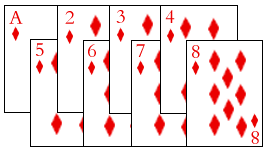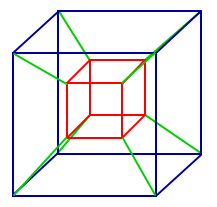
We know from the Fun Fact Seven Shuffles that 7 random riffle shuffles are enough to make almost every configuration equally likely in a deck of 52 cards.
But what happens if you always use perfect shuffles, in which you cut the cards exactly in half and perfectly interlace the cards? Of course, this kind of shuffle has no randomness. What happens if you do perfect shuffles over and over again?
There are 2 kinds of perfect shuffles: The out-shuffle is one in which the top card stays on top. The in-shuffle is one in which the top card moves to the second position of the deck. Figure 1 shows an out-shuffle.
Surprise: 8 perfect out-shuffles will restore the deck to its original order!
And, in fact, there is a nice magic trick that uses out and in shuffles to move the top card to any position you desire! Say you want the top card (position 0) to go to position N. Write N in base 2, and read the 0’s and 1’s from left to right. Perform an out-shuffle for a 0 and and in-shuffle for a 1. Voila! You will now have the top card at position N. (See the reference.)
Example. Since 6 is 110 in binary notation, then the sequence IN-IN-OUT will move the top card (position 0) to position 6 (the seventh card).
Presentation Suggestions:
Have students go home and determine how many in-shuffles it takes to restore the deck to its original order. (Answer: 52.) You can also have students investigate decks of smaller sizes. As a project, you might even tell them part of the binary card trick and see if they can figure out the rest: whether 0 or 1 stands for an in/out shuffle, and whether to read the digits from left to right or vice versa.
The Math Behind the Fact:
This fact may come as somewhat of a surprise, because there are 52! possible deck configurations, and since there is no randomness, after 52! out-shuffles, we must hit some configuration at least twice (and then cycle from there). But 8 is so much smaller than (52!). See Making History By Card Shuffling.
Group theory concerns itself with understanding sets and properties preserved by operations on those sets. For instance, the set of all configurations of a deck of 52 cards forms a group, and a shuffle is an operation on that group.
How to Cite this Page:
Su, Francis E., et al. “Perfect Shuffles.” Math Fun Facts. <http://www.math.hmc.edu/funfacts>.
References:
B. Morris, Magic Tricks Card Shuffling and Dynamic Computer Memories.
Fun Fact suggested by:
Francis Su

